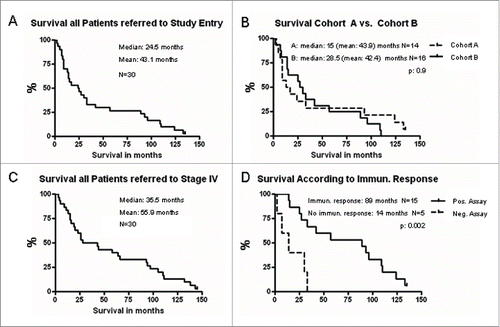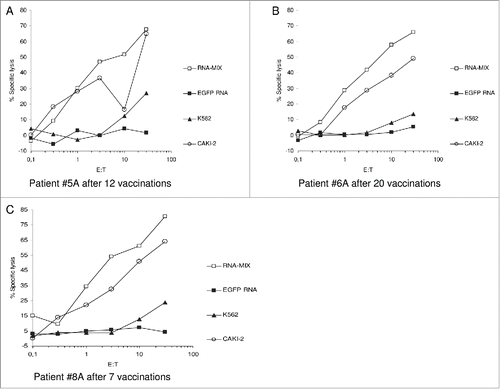Figures & data
Figure 1. Overall survival is depicted in Kaplan–Meier Plots (GraphPad Prism). The current update revealed median (mean) survival of 24.5 (43.1) mo for all patients included in the study based on timepoint of study entry (A). Overall survival of patients treated in cohort A versus cohort B. p = 0.9 (logrank test), Kaplan–Meier Plots (GraphPad Prism) (B). Overall survival based on the date of documented stage IV disease. Median (mean) survival reached 35.5 (55.9) mo as depicted in Kaplan–Meier Plots (GraphPad Prism) (C). Overall survival of patients with detectable immunological responses to the vaccinated TAA was significantly prolonged compared to patients with negative immunological assays (89 mo vs. 14 mo, p = 0.002, logrank test) as displayed. Of note, immunological assays could only be performed in 20 out of 30 patients (D).

Figure 2. Exemplary Immunological Assays in long-term Survivors. Cytotoxic T cells (CTL) were generated out of the patients (HLA-A2-) PBMC (obtained after onset of vaccination as mentioned) by stimulation with autologous DC transfected with an RNA-Mix (containing RNA coding for the vaccinated TAAs MAGE-A1, MUC1, CEA, and survivin). After re-stimulations CTL were used as effector cells in 51-chromium release assays. These vaccine-induced CTL efficiently lysed autologous DC electroporated with the RNA-Mix as well as the tumor cell line Caki-2 (RCC, HLA-A2-) while DC electroporated with irrelevant EGFP-RNA were not lysed. K562 was used to exclude NK-cell mediated toxicity.

